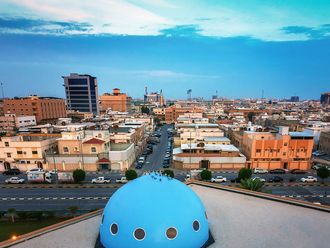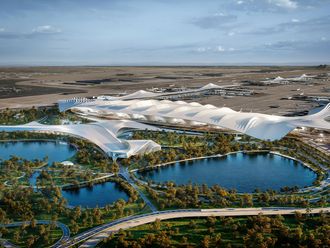
A decade ago, China's leaders gave the go-ahead to a colossal plan to bring more than 8 trillion gallons of water a year from the rivers of central China to the country's arid north. The project would have erected towering dams, built hundreds of miles of pipelines and tunnels, and created vast reservoirs with a price tag three times that of the giant Three Gorges Dam.
But the plan's biggest section, which was supposed to break ground this year, has run aground after a group of academics and experts voiced alarm about costs, environmental damage and earthquake dangers. Though a rare victory for ordinary citizens, the halting of that part of the project leaves behind water shortages that could cause the entire Chinese economy to founder.
The source of the water predicament is China's own economic success. A bigger economy means more factories and power plants, all prodigious users of water for processing and cooling. Big cities are getting bigger, using more drinking, shower and sewage water. People are eating better, and growing more food requires more water. They crave entertainment, too; the Beijing area has 100 golf courses and a dozen ski resorts with man-made snow.
Threat
The result has been a scramble for water that is pitting downstream communities against upstream ones, farmers against factories, and people concerned about the country's environment against those worried that water shortages might be the mighty Chinese economy's Achilles' heel. Unlike oil needs, which can be supplemented with imports, water needs pose a much more intractable threat to China's rise.
"China is facing two prominent challenges: water shortages and pollution," said Ma Jun, director of the Institute of Public and Environmental Affairs, a Beijing-based group. On top of that, "what's not receiving attention is the destruction of the river ecosystem, which I think will have long-term effects on our water resources."
The water diversion project, inspired by a 1952 suggestion by Mao Zedong, would have siphoned off about 5 per cent of the Yangtze River's water volume, a massive amount equal to six times the crude oil consumed worldwide.
The plan involved three routes, and official cost estimates have run as high as $75 billion. Two of the routes — in the eastern and central parts of the country — are moving ahead, though the central one is well behind schedule.
Some economists and geologists hope that their ability to persuade China's top leaders — eight out of the nine are engineers— to scuttle the western and largest route might signal a change in attitudes toward giant public works projects.
"We shouldn't celebrate [big projects] as a triumph over nature," Ma said. "We should humbly think about how we got cornered into such a situation."
Thirsty north
About 42 per cent of China's population lives in the arid north, which has about 8 per cent of the country's water resources. So while flooding regularly kills thousands of people to the south, northern China is thirsty. That's why Chinese leaders turned to the giant diversion project, and it's what made the successful effort to stop the western route so unusual.
The opposition was spearheaded by academics and experts, most notably Lu Jiagua, a soft-spoken retired economist at the Sichuan Academy of Social Sciences. In 2004, Lu published an article painting an alarming picture of the western route, and in early 2005, he sent it twice with letters to Premier Wen Jiabao.
One issue was the project's sheer size: seven dams and 630 miles of tunnels through mountains near Yangtze tributaries in western Sichuan and Qinghai provinces. The water needed to be raised by 1,650 feet to be fed into the Yellow River, which would carry the water to China's north.
The project would cross five earthquake faults in western Sichuan, the province rocked by a huge 2008 earthquake. One of the faults suffered 18 destructive quakes between 1901 and 1976. Cracks in new dams could swamp millions of homes, Lu said.
"The Sichuan earthquake was a warning," he said. "This is extremely, extremely dangerous."
The scheme would do harm all along the Yangtze, Lu said. Along the upper tributaries, it would inundate the ancient forests and grasslands already reduced by logging. Downstream, the siphoning of water from the Yangtze would diminish the flow to the giant Three Gorges hydroelectric project. Lu estimated that the loss of water would cost the government more than $3 billion a year in lower electricity output.
Initial estimates also omitted compensation for homes, factories or natural sites that would be destroyed by flooding. That would cost billions of dollars more.
Wen, the premier, ordered project planners to respond to Lu's points, setting off a fierce bureaucratic battle. In 2006, several dozen prominent economists and geologists sent Wen more materials. Then the earthquake struck. That clinched it. Ground was never broken, and last year the government cut off $7.3 million in funding for a key planning group, Lu said.
"This is the first time in the history of the People's Republic of China that just because of opposition from civil society and individuals that the central government stopped a project like this," he said.
The two other water diversion routes have also caused waves of troubles. The eastern leg, which won't be completed until 2013, takes advantage of the Grand Canal project constructed seven centuries ago. But the water may be too polluted for drinking.
The central route is still several years from completion, and controversy is mounting over the need to raise the height of the Danjiangkou dam. Unique cultural sites would be flooded, and at least 330,000 people would need to be relocated.
Water experts argue that there are better and cheaper ways to alleviate the country's water problems. About 60 per cent of the Yellow River's water goes to agricultural irrigation. Most of that flows to irrigation ditches such as those in the village of Shi Ting, southwest of Beijing, where water evaporates quickly in the dry climate.
Better irrigation techniques could save a third of the water now used, experts say. And the UN Development Programme estimates that Chinese industry uses four to 10 times as much water as counterparts in industrialised countries.
Pollution
Even if the water volume of the Yellow River could be increased, said Lu, it has been polluted by silt upriver and by coal mining sites below it. Although hundreds of new water treatment facilities have been built with money from the central government, local governments often leave them idle because they do not want to pay for operating costs.
"Hundreds of sewage plants have been built around China, but we haven't seen our water getting cleaner," said Ma, director of the environmental institute.
"We have more than 600 records of violations by sewage plants discharging above standards or simply not treating at all or not properly disposing of the sludge."
In the meantime, the water wars continue.
Beijing, whose population of 17 million is growing by about 300,000 people a year, has been sucking up all the water it can. To the city's northwest, water in the polluted Guanting reservoir is no longer fit for drinking.
The scenic Miyun reservoir, northeast of the city, feeds channels that end at the historic Summer Palace. In the past decade, it has fallen to a third of its capacity, according to He Qingcheng, deputy chief engineer of the China Institute of Geo-Environmental Monitoring. So Beijing has cut off the outlet that fed a river that leads to the city of Tianjin, depriving Tianjin of vital water supplies.
Shortages have spurred the drilling of new wells. Underground aquifers now provide three-quarters of Beijing's water supply, but the water table is falling. He, a groundwater expert, said Beijing is drilling down to 1,000 feet, five times as deep as 20 years ago.
To encourage more frugal use, Beijing late last year raised water prices for commercial and industrial use by 11 to 50 per cent and for residential use by 8 per cent. But water use per person in China is one-ninth the US level; if northern China were a country, its water availability would rank below Morocco's, the UN. Development Programme says.
One battleground
One small battleground in China's water wars lies in Shi Ting, where Tian Xirui recently stood beside an irrigation ditch, pointing to the snow-covered corn stubble in his tiny plot and bemoaning the lack of water for his crops.
About five years ago, the nearby Juma River was diverted to meet the needs of the state-owned Yanshan Petrochemical plant, and the village's irrigation ditches ran dry. So Tian, who used to harvest about 35 bushels of wheat in addition to corn, recently stopped planting wheat because it needs to be watered three times a year.
Nowadays, just quenching his family's drinking-water needs is a challenge. Almost every household in the village now has its own well. Tian shares one with five other families, and they are reaching deeper and deeper — 335 feet — to find water.
"Even if you have a different view about the petrochemical plant, it is no use to protest if you're an ordinary farmer," said Li Fengran, Tian's wife.
"How can you compete with these people at high levels?" Tian added that "even if there's compensation, we wouldn't know. It would just go to officials."
Tian, who lives just a two-hour drive from Beijing's new skyscrapers, earns less than $1 a day selling corn.
He has given the larger of the two rooms in his house to his daughter, who works in a village clothing factory, and his son-in-law, who makes decent money driving a construction truck.
Between the village and Beijing, workers were recently braving subfreezing temperatures to lay a pipeline as part of the central route for the water diversion scheme.
But like much of China's progress, this too will bypass the Juma River and the hard scrabble farmers of Shi Ting.












